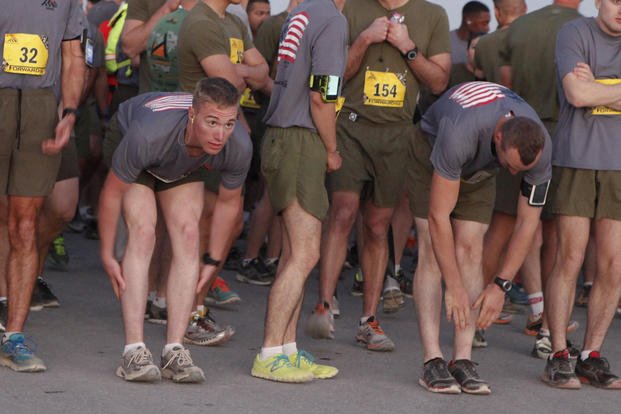As promised in the "Get Back on the Fitness Horse" article, the following stretching plan will assist you with starting an exercise program safely and without as much soreness.
The stretching program
Increasing one's flexibility should be your first goal before starting a fitness program. If you are thinking about beginning a fitness program and you have been idle for many years, you should stretch for an entire week before starting running, lifting weights or doing any calisthenics.
It is OK to walk to warm up, however. Your first 1-2 weeks of starting a fitness program should consist of the following stretches 1-2 times a day, and walking, biking or some other non-impact, low-intensity cardio activity for 10-15 minutes. You also should drink 2-3 liters of water a day.
Follow the stretching chart after your workout. Hold these stretches or do these movements for at least 15-20 seconds each:
- Shoulder shrugs
- Chest and biceps stretch
- Forearm stretch
- Arm and shoulder stretch
- Triceps and lat stretch (half moon)
- Stomach stretch
- Calf stretch
- Lower back stretch
- Iliotibial band (ITB)/hip
- Hamstring stretch
- Thigh stretch -- standing or lying on floor
Stretch in this order to aid in major muscle-group stretching. Stretching the connecting groups of the thighs and hamstrings first will assist in a more thorough stretch of the hamstrings and thighs -- the major muscle groups of the body.
Stretching and warming up
Holding these stretches for 15-20 seconds is the best way to end your workout. Do not bounce when performing these stretches and inhale deeply for three seconds, hold for three seconds and fully exhale. Do this twice per stretch. This will take you to the 15- to 20-second time minimum for holding these stretches for optimal results.
Shoulder shrugs: Rotate your shoulders slowly up and down, keeping your arms relaxed by your side. Your shoulders should rotate in small circles and move up and down in slow distinct movements.
Chest stretch: Grab a vertical and stationary object with your hand. Pull your body away from your arm in order to feel the stretch of your chest and shoulder connection. Also stretches your biceps.
Forearm stretch: With your opposite hand, pull backward on your hand while keeping your arm straight and palm pointing upward. You will feel this stretch in the forearm and biceps/elbow connection.
Arm/shoulder stretch: Drop your shoulder and pull your arm across your chest. With the opposite arm, gently pull your arm across your chest and hold for 15 seconds. Repeat with the other arm.
Triceps into back stretch: Place both arms over and behind your head. Grab your right elbow with your left hand and pull your elbow toward your opposite shoulder. Lean with the pull. Repeat with the other arm.
Stomach stretch: Lie on your stomach. Push yourself up to your elbows. Slowly lift your head and shoulders and look up at the sky or ceiling. Hold for 15 seconds and repeat two times.
Calf stretch into Achilles' tendon stretch: Stand with one foot 2-3 feet in front of the other. With both feet pointing in the same direction as you are facing, put most of your body weight on your leg that is behind you, stretching the calf muscle. Now bend the rear knee slightly. You should feel the stretch in your heel. This stretch helps prevent Achilles' tendinitis, a severe injury that will sideline most people for about 4-6 weeks.
ITB stretch: Sit on the ground with your legs crossed in front of you. Keeping your legs crossed, bring the top leg to your chest and bend it at the knee so that your foot is placed outside of your opposite leg's thigh. Hold your knee for 15 seconds against your chest and repeat with the other leg. Note: Before and after running, you should perform the ITB stretch. This will help prevent very common overuse injuries in the hips and knees.
Thigh stretch standing: Standing, bend your knee and grab your foot at the ankle. Pull your heel to your butt and push your hips forward. Squeeze your butt cheeks together and keep your knees close together. You can hold on to something for balance if you need to, or you can lie down on your hip and perform this stretch.
The lower back is the most commonly injured area of the body. Many lower-back problems stem from inactivity, lack of flexibility and improper lifting of heavy objects. Stretching and exercising your lower back will help prevent some of those injuries. See lower-back stretches and exercises in the "Workouts to Prevent Injury" article.
Hamstring stretch #1: From the standing or sitting position, bend forward at the waist and touch your toes. Keep your back straight and slightly bend your knees. You should feel this stretching the back of your thighs.
Bend knees slightly to stretch the top side of the hamstring as well as the lower back.
All stretches above should be done daily -- even two times daily for about 15 minutes each session for two weeks before you really start to work out.
This program should help you get started with a stretching program of the major muscle groups.
Stew Smith is a former Navy SEAL and fitness author certified as a Strength and Conditioning Specialist (CSCS) with the National Strength and Conditioning Association. Visit his Fitness eBook store if you’re looking to start a workout program to create a healthy lifestyle. Send your fitness questions to stew@stewsmith.com.
Want to Learn More About Military Life?
Whether you're thinking of joining the military, looking for fitness and basic training tips, or keeping up with military life and benefits, Military.com has you covered. Subscribe to Military.com to have military news, updates and resources delivered directly to your inbox.


















